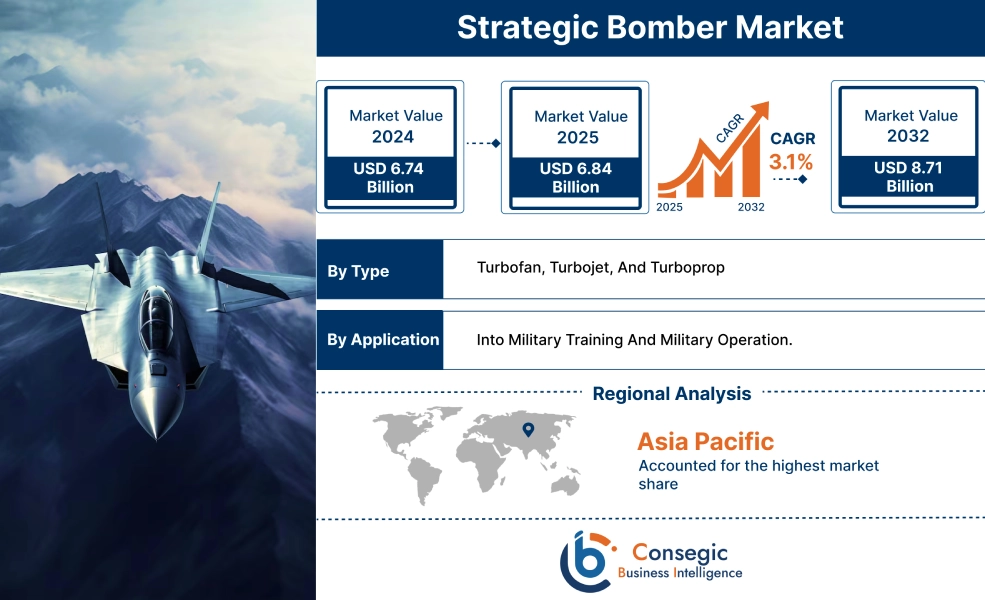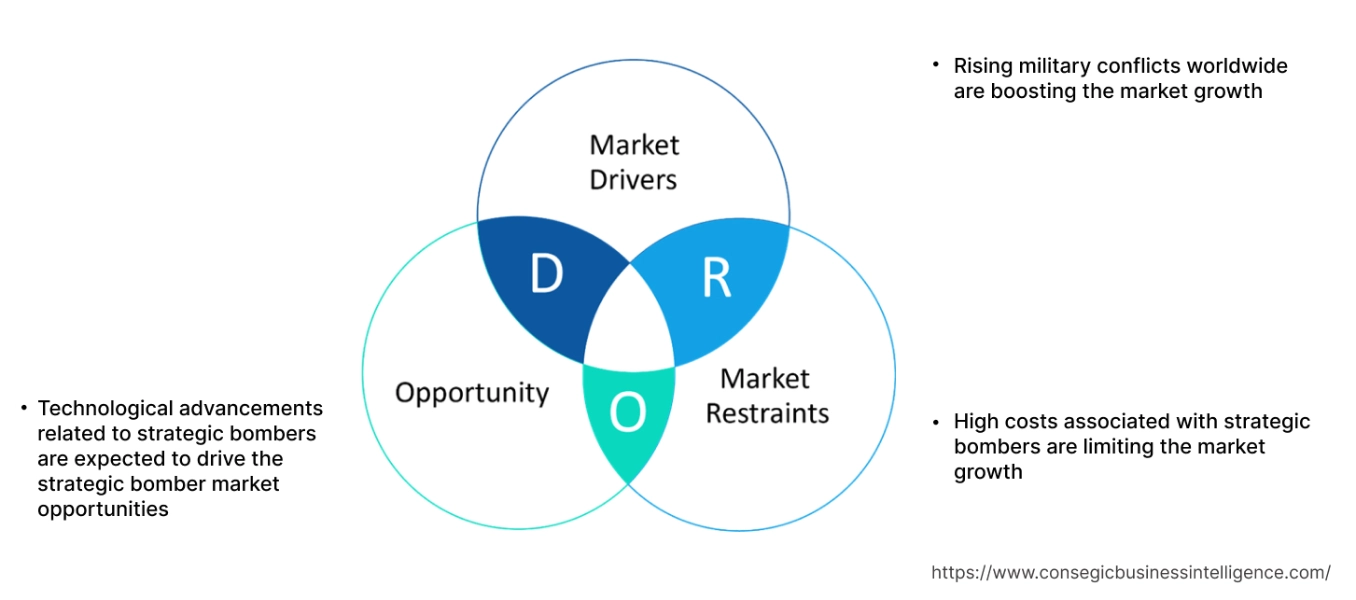Strategic Bomber Market Size:
Strategic Bomber Market size is estimated to reach over USD 8.71 Billion by 2032 from a value of USD 6.74 Billion in 2024 and is projected to grow by USD 6.84 Billion in 2025, growing at a CAGR of 3.1% from 2025 to 2032.
Strategic Bomber Market Scope & Overview:
Strategic bombers are long-range aircraft designed to deliver massive payloads, including conventional or nuclear weapons, to distant targets. They are crucial for achieving strategic objectives, such as disrupting an enemy's ability to wage war by targeting their infrastructure, industrial capacity, and military installations. They are designed to carry significant quantities of ordnance, including conventional bombs, cruise missiles, and nuclear weapons. These bombers often incorporate sophisticated technologies for navigation, target acquisition, and weapons delivery. Many bombers are equipped to carry and deliver nuclear weapons, making them a key component of nuclear deterrence strategies.
How is AI impacting the Strategic Bomber Market?:
AI is significantly impacting the development and operation of strategic bombers, enhancing their capabilities in areas like autonomous navigation, target acquisition, and electronic warfare. AI enables strategic bombers to process vast amounts of data and make real-time decisions, improving mission effectiveness. Also, AI can integrate drone swarms with strategic bombers, potentially acting as loyal wingmen or battlefield sensors. Further, AI-powered systems can be used for autonomous navigation, threat assessment, and target acquisition, potentially reducing reliance on human pilots in certain scenarios.
Strategic Bomber Market Dynamics - (DRO) :
Key Drivers:
Rising military conflicts worldwide are boosting the market growth
The number of global armed conflicts has increased significantly, with a notable increase in high-intensity armed conflicts and conflict-related fatalities. This trend is driven by ongoing conflicts in regions like the Middle East, Africa, and Europe, as well as the emergence of new conflicts. The escalation of conflicts is leading to a growing humanitarian crisis, with millions of people displaced and in need of assistance.
- For instance, World Population Review stated that around 102,363 casualties were recorded in 5 top countries including Ukraine, Palestine, Mynammar, Sudan, and Ethopia due to war in 2024.
Thus, the aforementioned factors are boosting the adoption of these bombers, in turn driving the strategic bomber market growth.
Key Restraints:
High costs associated with strategic bombers are limiting the market growth
Strategic bombers are capable and versatile weapon platforms, however, they are often expensive to acquire, operate, and maintain, which leads to limited adoption, particularly by nations with budgetary constraints or alternative priorities. These bombers are technologically complex and require significant resources for development, production, and ongoing maintenance. Their high cost, coupled with the ongoing need to modernize and upgrade, strains the defense budgets. Thus, the market analysis shows that the aforementioned factors are restraining the strategic bomber market demand.
Future Opportunities :
Technological advancements related to strategic bombers are expected to drive the strategic bomber market opportunities
Strategic bombers incorporate stealth features to evade radar detection. This includes materials and shapes that reduce radar reflectivity and minimize visual and acoustic signatures. Modern bombers, including the B-1B Lancer and the B-2 Spirit, have significantly increased range, allowing them to strike targets far from their home bases. Moreover, new bombers feature AI-assisted avionics, which enhance situational awareness and improve mission effectiveness.
Thus, the ongoing advancements related to these bombers are projected to drive the strategic bomber market opportunities during the forecast period.
Strategic Bomber Market Segmental Analysis :
By Type:
Based on the type, the market is segmented into turbofan, turbojet, and turboprop.
Trends in the Type:
- Rising adoption of turboprop bombers for patrolling in short-distance ranges is boosting the strategic bomber market size.
- Increasing demand for turbofan bombers to carry heavy payloads of bombs and missiles is driving the market growth.
The turbofan segment accounted for the largest revenue share of 45.80% of the overall strategic bomber market share in 2024.
- A turbofan strategic bomber is a type of aircraft designed for long-range, deep-penetration strikes into enemy territory, typically carrying a large payload of bombs or missiles, often with the capability to deliver nuclear weapons.
- These aircraft are powered by turbofan engines, which provide efficient thrust for long-range flight and high payload capacity.
- These aircraft carry a substantial amount of bombs, missiles, or nuclear weapons and are capable of delivering both conventional and nuclear weapons.
- Therefore, the market analysis depicts that the aforementioned factors are boosting the strategic bomber market growth.
The turbojet segment is expected to register the fastest CAGR growth during the forecast period.
- Turbojet engines provide the necessary power for these bombers to fly great distances, often exceeding 10,000 kilometers.
- Turbojets allow these aircraft to achieve high speeds, both for rapid transit and to evade interception.
- They play a crucial role in nuclear deterrence and power projection, capable of striking targets within enemy territory.
- Thus, the market analysis shows that the aforementioned factors are expected to drive the strategic bomber market trends during the forecast period.
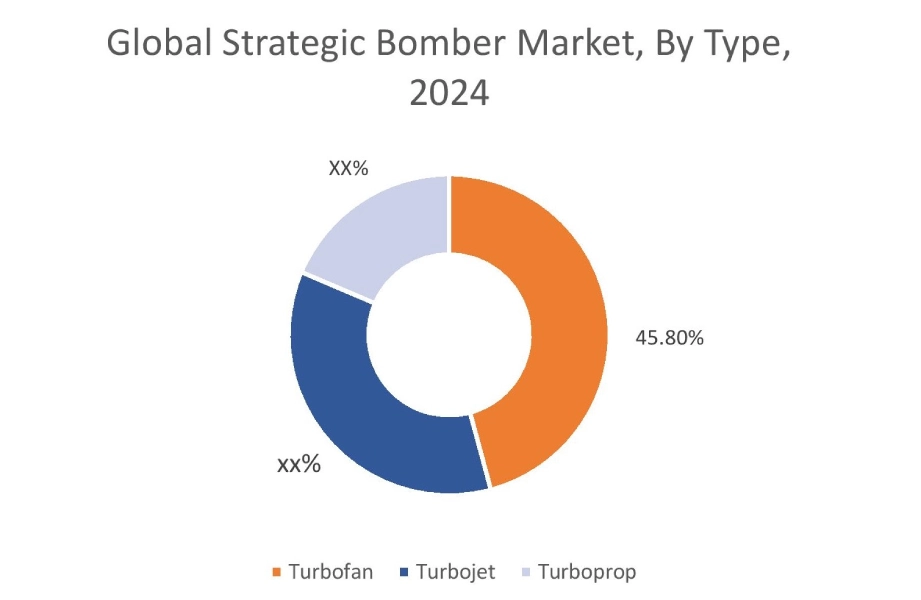
By Application:
Based on the application, the market is segmented into military training and military operation.
Trends in the Application:
- Rising demand for strategic bombers to monitor maritime activities of enemy forces and gather intelligence is boosting the strategic bomber market size.
- Increasing demand for strategic bombers to enable crews to develop the skills and knowledge needed to execute complex and high-stakes missions.
The military operation segment accounted for the largest revenue share of the total strategic bomber market share in 2024.
- Strategic bombers, designed for long-range bombing missions, play a crucial role in military operations by targeting enemy infrastructure, logistics, and industrial facilities to weaken their ability to wage war.
- In the event of a conflict, strategic bombers are used to deliver nuclear weapons against strategic targets to neutralize the enemy's ability to fight.
- Their long range allows them to penetrate enemy territory to strike targets that would be difficult for shorter-range aircraft to reach.
- Therefore, the aforementioned factors are boosting the strategic bomber market demand.
The military training segment is expected to register the fastest CAGR growth during the forecast period.
- Strategic bombers play a vital role in military training, simulating and preparing for real-world scenarios.
- They are used to train crews in long-range bombing missions, target acquisition, and air-to-air combat tactics.
- Simulations also help develop strategic thinking and understanding of the impact of large-scale air power operations.
- Thus, the aforementioned factors are expected to boost the strategic bomber market trends during the forecast period.
Regional Analysis:
The regions covered are North America, Europe, Asia Pacific, the Middle East and Africa, and Latin America.
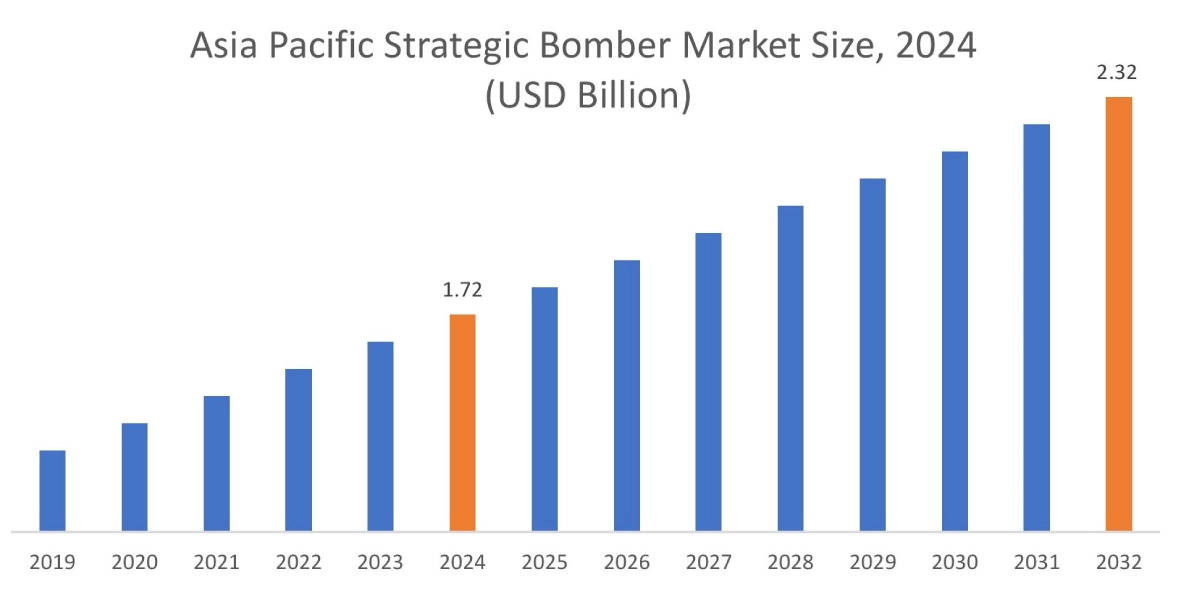
Asia Pacific region was valued at USD 1.72 Billion in 2024. Moreover, it is projected to grow by USD 1.76 Billion in 2025 and reach over USD 2.32 Billion by 2032. Out of this, China accounted for the maximum revenue share of 35.60%. The strategic bomber market analysis shows that the market growth in the region is proliferating due to increasing expenditure in the defense industry and rising conflicts between countries in the region. Moreover, the presence of terrorist groups in the region leads to the adoption of strategic bombers for patrolling and military operations, thereby boosting the strategic bomber market expansion.
- For instance, the World Bank Group stated that India’s Defense Budget was USD 83.57 Billion in 2023, an increase of 4.5% as compared to USD 79.98 Billion in 2022. The above factors are driving the market in the Asia-Pacific region.
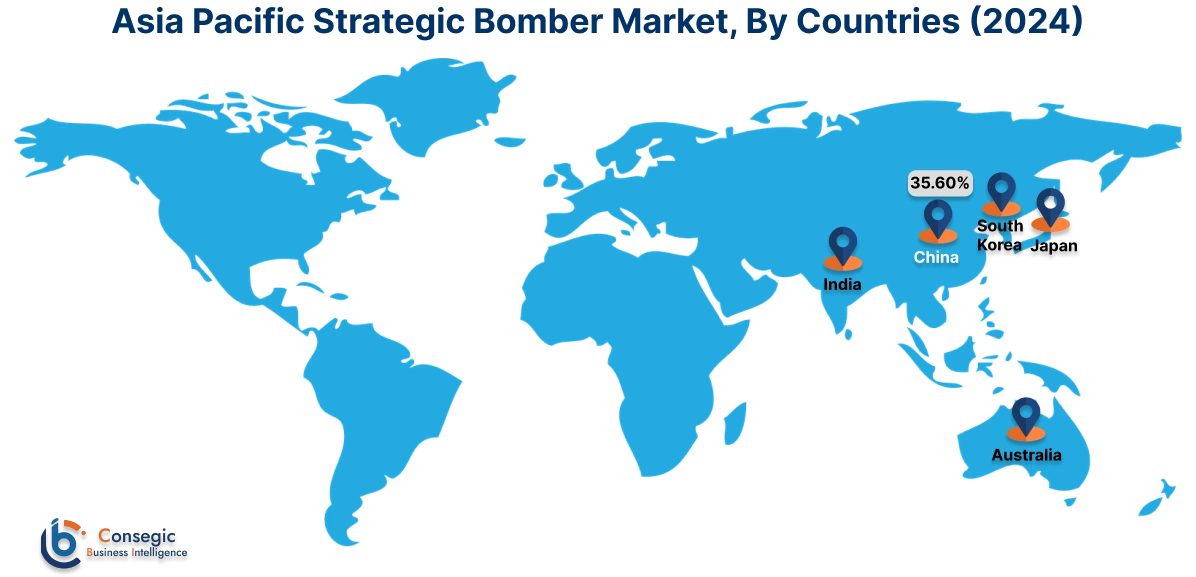
North America is estimated to reach over USD 3.68 Billion by 2032 from a value of USD 2.86 Billion in 2024 and is projected to grow by USD 2.90 Billion in 2025. The market in the region is growing due to well-established aerospace and defense industry. Moreover, the market is driven by a combination of military modernization, geopolitical considerations, and technological advancements among others.
The strategic bomber market analysis depicts that the market in the European region is growing due to the demonstration of combat readiness, reinforcement of global security, and training with NATO Allies. In Latin America, Middle East, and Africa, the market is growing due to the rising need for strategic bombers to handle primary security challenges, such as terrorism and political instability. The above factors are boosting the strategic bomber market expansion in the regions.
Top Key Players and Market Share Insights:
The strategic bomber industry is highly competitive with major players providing solutions to the national and international markets. Key players are adopting several strategies in research and development (R&D), product innovation, and end-user launches to hold a strong position in the global strategic bomber market. Key players in the strategic bomber industry include -
- Northrop Grumman Corporation (USA)
- PJSC Tupolev (Russia)
- General Dynamics Corporation (USA)
- Xian Aircraft Industrial Corporation (China)
- Lockheed Martin (USA)
- Rockwell Automation, Inc. (USA)
- The Boeing Company (USA)
- Collins Aerospace (USA)
- BAE Systems (United Kingdom)
- Dassault Aviation SA (France)
Strategic Bomber Market Report Insights :
| Report Attributes | Report Details |
| Study Timeline | 2019-2032 |
| Market Size in 2032 | USD 8.71 Billion |
| CAGR (2025-2032) | 3.1% |
| By Type |
|
| By Application |
|
| By Region |
|
| Key Players |
|
| North America | U.S. Canada Mexico |
| Europe | U.K. Germany France Spain Italy Russia Benelux Rest of Europe |
| APAC | China South Korea Japan India Australia ASEAN Rest of Asia-Pacific |
| Middle East and Africa | GCC Turkey South Africa Rest of MEA |
| LATAM | Brazil Argentina Chile Rest of LATAM |
| Report Coverage |
|
Key Questions Answered in the Report
How big is the strategic bomber market? +
Strategic Bomber Market size is estimated to reach over USD 8.71 Billion by 2032 from a value of USD 6.74 Billion in 2024 and is projected to grow by USD 6.84 Billion in 2025, growing at a CAGR of 3.1% from 2025 to 2032.
What are the major segments covered in the strategic bomber market report? +
The segments covered in the report are type, application, and region.
Which region holds the largest revenue share in 2024 in the strategic bomber market? +
Asia Pacific holds the largest revenue share in the strategic bomber market in 2024.
Who are the major key players in the strategic bomber market? +
The major key players in the market are Northrop Grumman Corporation (USA), PJSC Tupolev (Russia), Rockwell Automation, Inc. (USA), The Boeing Company (USA), Collins Aerospace (USA), BAE Systems (United Kingdom), Dassault Aviation SA (France), General Dynamics Corporation (USA), Xian Aircraft Industrial Corporation (China), and Lockheed Martin (USA).
